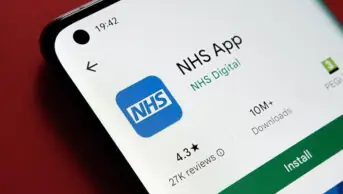
Shutterstock.com/The Pharmaceutical Journal
After reading this article, you should be able to:
- Be aware of the ePMA configurations and functionalities that require careful consideration in paediatrics; and
- Understand ePMA implementation considerations for paediatric settings.
Electronic prescribing and medicines administration (ePMA) systems can improve the accuracy and efficiency of medicines management; however, paediatric patients have unique attributes, meaning that systems designed for adult patients are not suitable for them. Varying weight, clinical conditions and developmental stages mean that paediatric patients require individualised drug dosing, and off-label and unlicensed medicines formulations. For more information on this topic, visit The Pharmaceutical Journal’s paediatric collection.
This article is the second of a two-part series. Part one discusses the benefits of ePMA systems and what should be considered when designing or updating a system. This article explains what to consider when implementing a new system or changes.
Process mapping
The degree of change that ePMA implementation will introduce cannot be underestimated. The transition from paper-based prescribing and medicines administration documentation to an electronic system would impact several processes beyond just medicines prescribing and administration. Therefore, it is essential to include process mapping in the workstream. A process map is a visual tool that outlines the sequence of actions of a process. It also aids in understanding existing workflows, engaging with stakeholders and guiding system design and implementation.
It is crucial to focus on the current processes, as many unknown workflows may be uncovered. For example, in a paediatric setting, patients often attend as ward attenders or are discharged for short-term leave. These processes require careful consideration to ensure patient flow is not adversely impacted by the introduction of an ePMA system. Potential issues need to be escalated appropriately, with plans developed to review and resolve them by the relevant teams. This requires clear communication and collaboration across multiple teams and departments when defining the future processes.
In addition, examining processes within the pharmacy and at ward level is essential. For example, clinical pharmacy workflow, medicines supply and dispensing processes must be considered to ensure effective practices — such as medicines reconciliation and clinical checking — are maintained.
Pharmacy processes
To optimise inpatient pharmacy workflow, consider introducing additional systems to streamline and improve these processes, such as a pharmacy tracking system and reporting system to create pharmacy dashboards. The dashboard can pull live data from the ePMA database and provide detailed clinical information from each ward. This can provide significant benefits by prioritising patients on high-risk drugs or identifying newly prescribed drugs that have not yet been clinically checked. In paediatric patients, clear documentation of formulations and strengths is crucial, owing to the frequent use of unlicensed medicines. It is critical that these points are clearly documented throughout the patient’s inpatient admission and discharge documentation to primary care settings. This is particularly relevant in paediatric care, because serious errors have occurred at the primary care interface1. Patients who need particular attention include those who have not had a medicines reconciliation, or who have new drug prescriptions, unverified drugs, high-risk drugs, prescribed infusions, antibiotics and completed discharge medicines. A dashboard enables the pharmacy team to manage the ordering of medicines for the aseptic unit, antimicrobial stewardship and prioritise daily tasks effectively.
A pharmacy prescription tracker system can be configured to pick live data from the ePMA database. The system can automatically pick up new drug orders made by nurses or doctors and triage them in different stages in dispensary. Live data tracking is helpful in daily practice but particularly useful when ward service coverage requires prioritisation (e.g. during staff shortages or surge planning).
These supplementary systems can be developed and set up by a trust’s IT department or any ePMA staff with IT and clinical informatics expertise. Additionally, there are commercial products available on the market that come with configuration and maintenance services from the suppliers.
Clinician engagement
Engaging with specialists and clinicians from the outset is critical to the successful implementation of ePMA systems. Their insights and expertise are invaluable in tailoring the system to meet the specific needs of paediatric patients. Involving clinicians early helps to identify potential challenges, ensure the system meets their clinical requirements and workflows, and fosters a sense of ownership and buy-in that reduces resistance to change. Regular feedback and engagement sessions with clinicians help refine the system and ensure that it is user friendly and effective.
Subject matter experts
Having a subject matter expert in each specialty is essential to address specific needs and concerns from their own specialty. The experts can act as liaisons between the implementation team and their specialty, providing support to their colleagues. They are the advocates for the project and often help address concerns and reduce resistance. By leveraging the expertise of these subject matter experts, the implementation process can be smoother and more tailored to the needs of different specialties within paediatric care.
Liaising with system supplier
Close collaboration with the system supplier is necessary to address any issues that arise within the system. This includes establishing a streamlined process to review any issues when the system is not working as expected and working with them to customise the system to meet paediatric-specific needs. Effective communication with the system supplier ensures that the system remains functional and reliable, minimising disruptions to clinical workflows and aligning with NHS Digital clinical safety strategy and digital clinical safety standards: DCB0129 and DCB01602,3.
Devices
Process mapping will also identify criteria that will be considered essential for the devices that are used to access the ePMA system. The devices used to access the ePMA system play a significant role in its effectiveness. Considerations include:
- Portability and size: Large mobile devices, such as computers on wheels, may not always be suitable when space is limited. It may possess risk to patients if children are active in ward areas;
- Drug rounds: Paediatric wards may not have set times for drug rounds. The use of large drug trolleys may not be suitable as multiple staff may require access to the trolley to administer drugs at the same time, in the same area;
- Infection control consideration: Devices used in paediatric settings should be easy to clean and have covers to protect them from liquid spills, which is a commonly used formulation in paediatric medicines;
- Cubicle size: Paediatric wards often have more cubicles, but they may not be able to accommodate large computers on wheels, portable devices or monitor arms.
Go-live planning
A detailed go-live plan is crucial for a smooth transition to the new electronic system. The plan should include an appropriate go-live date, preferably during a period of lower patient volume, in consideration of the staff holiday period and avoiding winter pressures. This involves assembling a support team of ePMA and IT professionals, trainers and small- and medium-sized enterprises to provide on-site assistance, which develops contingency plans to address potential system downtime quickly and efficiently. Organising simulation sessions to simulate real-world scenarios can refine the processes and identify missing gaps in actual practice. This preparation work ensures that the system is suitable for the workflows and that staff are prepared to use it effectively. Effective go-live planning ensures a seamless transition, minimising disruptions to patient care and allowing for immediate resolution of any issues that arise.
Training
The core team members who have configured the system should be involved in instructing the trainers to standardise the training process for each staff group. It is essential to identify vital training themes and develop tailored and easily accessible training content. For example, given that doctors often lack dedicated training time, the training should be flexible and made available face-to-face, remote or in ad hoc sessions. Creating resources, such as quick guides and posters, can serve to provide reminders of certain essential procedures. Additional training support may also be required during go-live and it is crucial to capture staff returning from maternity or long-term sick leave. Super-users can be designated to support EPMA go-live team out of hours during the go-live period, ensuring continuous support and training is available 24 hours a day for the staff during go-live.
Seek out feedback after implementation
After rolling out an ePMA system, it is essential to identify and integrate business-as-usual activities to address common issues and optimise system use. Effective system optimisation can only be achieved through communication and training. Engaging with users post-implementation encourages constructive discussions about how the system affects their daily roles and can elicit invaluable feedback. While many users may be familiar with the system basics, further conversations often reveal misunderstandings and limited knowledge of additional functionalities. Seeking out this feedback enables the ePMA team to fine-tune the system to better match user needs. A significant commitment to this embedding process should be made in all digital implementation plans.
Conclusion
Although ePMA systems offer substantial benefits for paediatric medicines management, careful consideration of the unique needs of paediatric patients is essential. By addressing specific challenges and continuously optimising system functionalities and processes, clinicians can significantly enhance the safety and efficacy of paediatric care, ultimately leading to better health outcomes for children.
The RPS Foundation Pharmacist Framework
This article is aimed to support the development of knowledge and skills related to the following credentialing areas:
Domain 1.1: Applies evidence-based clinical knowledge to make suitable recommendations or take appropriate actions;
Domain 1.6: Uses own pharmaceutical knowledge to positively impact the usage and stewardship of medicines at an individual and population level;
Domain 3.2: Critically appraises appropriate information to make a decision in an efficient and systematic manner; adopts evidence informed solutions;
Domain 3.5: Manages uncertainty and possible risk appropriately, while ensuring high attention to detail is maintained when making decisions regarding the individual receiving care;
Domain 3.6: Demonstrates an understanding that data can support improving care; values the importance of the skills required for the interpretation, analysis and the effective use of data within clinical practice; considers how to use data to improve the outcomes for individuals.
The Competency Framework for all Prescribers
This article is aimed to support the development of knowledge and skills related to the following competencies:
Domain 4.9: Electronically generates and/or writes legible, unambiguous and complete prescriptions which meet legal requirements;
Domain 4.10: Effectively uses the systems necessary to prescribe medicines.
- 1.Fox A, Portlock J, Brown D. Electronic prescribing in paediatric secondary care: are harmful errors prevented? Arch Dis Child. 2019;104(9):895-899. doi:10.1136/archdischild-2019-316859
- 2.DCB0129: Clinical Risk Management: its Application in the Manufacture of Health IT Systems. NHS England. June 15, 2023. https://digital.nhs.uk/data-and-information/information-standards/information-standards-and-data-collections-including-extractions/publications-and-notifications/standards-and-collections/dcb0129-clinical-risk-management-its-application-in-the-manufacture-of-health-it-systems
- 3.DCB0160: Clinical Risk Management: its Application in the Deployment and Use of Health IT Systems. NHS England. June 15, 2023. https://digital.nhs.uk/data-and-information/information-standards/information-standards-and-data-collections-including-extractions/publications-and-notifications/standards-and-collections/dcb0160-clinical-risk-management-its-application-in-the-deployment-and-use-of-health-it-systems
You might also be interested in…
Prescription tracking app to be used by more than 5,000 pharmacies within a year, says NHS England

Patients to be able to nominate a pharmacy on NHS App more easily from July 2025
